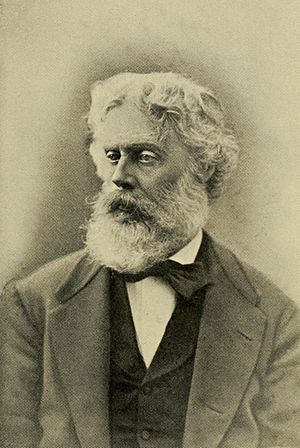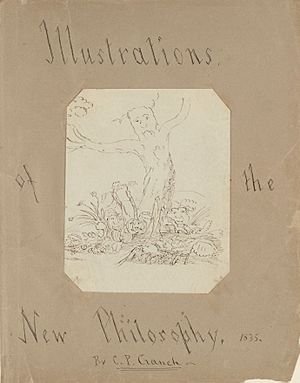Christopher Pearse Cranch facts for kids
Christopher Pearse Cranch (born March 8, 1813 – died January 20, 1892) was an American writer and artist. He was known for his poems, children's fantasy books, and landscape paintings.
Who Was Christopher Pearse Cranch?
Christopher Pearse Cranch was born in Washington, D.C.. His father, William Cranch, was a very important judge. His brother, John, was also a painter.
Cranch went to Columbian College, which is now called George Washington University. He graduated in 1835. After that, he studied at Harvard Divinity School and became a minister. He traveled around, preaching in many cities like Boston, Washington, and St. Louis.
Later in his life, Cranch had many different jobs. He worked as a magazine editor and a caricaturist. A caricaturist draws funny pictures of people. He also wrote children's fantasy books, like the Huggermugger series. Cranch was also a poet, and he published a book of poems called The Bird and the Bell with Other Poems in 1875. He was also a translator and a landscape painter. He spent much of his life living in Cambridge, Massachusetts. In 1843, he married Elizabeth DeWindt.
Cranch was connected to a group of thinkers called the Transcendentalists. He read important essays by Ralph Waldo Emerson, a famous writer. Cranch even reviewed Emerson's speech called "The American Scholar". He thought it was "full of original thought." Being linked to the Transcendentalists made it harder for Cranch to find work as a minister.
His poems appeared in magazines like The Harbinger and The Dial. One of his most famous poems, "Enosis," was sent to Emerson for The Dial in 1840.
Cranch as an Artist
As an artist, Cranch painted beautiful landscapes. His paintings were similar to those by Thomas Cole and artists from the Hudson River School. He also painted like artists from the Barbizon school in France.
One time, Cranch painted a historical event: the burning of P. T. Barnum's American Museum in New York City. Later in his life, he painted many scenes from Venice and other parts of Italy.
Cranch was also known for his funny caricatures of Ralph Waldo Emerson. These drawings were later put into a book called Illustrations of the New Philosophy: Guide. His most famous drawing is a caricature that shows Emerson's idea of the "transparent eyeball".
In 1850, Cranch became an Associate Academician at the National Academy of Design. He became a full Academician in 1864. This was a big honor for an artist.
Christopher Pearse Cranch passed away in 1892. He was buried at Mount Auburn Cemetery in Massachusetts.
Cranch's Books and Works
- Poems (1844)
- The Last of the Huggermuggers, A Giant Story (1855)
- Kobboltozo, A Sequel to the Last of the Huggermuggers (1857)
- The Aeneid of Virgil (translation, 1872)
- Satan: A Libretto (1874)
- The Bird and the Bell with Other Poems (1875)
- Ariel and Caliban with Other Poems (1887)
See also
 In Spanish: Christopher Pearse Cranch para niños
In Spanish: Christopher Pearse Cranch para niños



